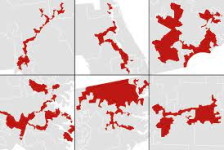PART I STATES COMPLETED REDISTRICTING
42 states have completed their redistricting, 8 more remaining. The democrats have a 14-seat gerrymandering edge so far. 11 new Democratic districts added, minus 3 Republican districts. We now have 337 newly drawn districts; 98 districts remain to be redrawn.
Out of the 337 newly drawn districts, there are 34 competitive, switchable districts. Currently held by 22 Democrats and 12 Republicans. Safe seats as of 20 Feb 2022, 162 Democratic, 141 Republican.
The below listed states are in litigation over their new maps. How these lawsuits turnout will probably change the above listed safe and competitive seats. Listed also is which state legislature drew the maps being challenged.
Georgia – Republican legislature
Maryland – Democratic legislature
Nevada – Democratic legislature
New Mexico – Democratic legislature
New York – Democratic legislature
Texas – Republican legislature
_____________________________________________________________________________________
PART II Safe Seat/Competitive seat watch
As of 20 Feb, the Democrats have 162 safe seats to 141 safe Republican seats. A 21-seat Democratic advantage. There are 8 states remaining who haven’t completed their redistricting which will change the above.
The importance of safe seats is that they let you know how many seats from the competitive column a party must win to gain control of the House. As of today, the democrats need 56 more seats to reach the magic number of 218. The Republicans need 77. It remains to be seen how many safe seats each of the 8 remaining states add to each party’s safe seat column. The 8 remaining states are New Hampshire, Pennsylvania, Ohio, North Carolina, Florida, Louisiana, Missouri and Wisconsin.
In short to remain in control of the House, the Democrats need 56 seats above their safe seat number. The Republicans need 77 above their safe seat number to take control of the house. 34 seats are in the competitive/switchable column, 22 Democratic, 12 Republican along with 98 more districts to be redrawn in which to obtain those seats from.
With 42 states in the books, it’s far from a guarantee that the Republicans regain control of the house. With Republican states of Ohio, North Carolina, Florida, Louisiana and Missouri left, those states will certainly narrow the 21-seat safe seat margin the Democrats have today, if not overtake it. There are also the swing states of New Hampshire, Pennsylvania and Wisconsin left. No Democratic states. I’ll update this as the pending states complete their redistricting.
42 states have completed their redistricting, 8 more remaining. The democrats have a 14-seat gerrymandering edge so far. 11 new Democratic districts added, minus 3 Republican districts. We now have 337 newly drawn districts; 98 districts remain to be redrawn.
Out of the 337 newly drawn districts, there are 34 competitive, switchable districts. Currently held by 22 Democrats and 12 Republicans. Safe seats as of 20 Feb 2022, 162 Democratic, 141 Republican.
The below listed states are in litigation over their new maps. How these lawsuits turnout will probably change the above listed safe and competitive seats. Listed also is which state legislature drew the maps being challenged.
Georgia – Republican legislature
Maryland – Democratic legislature
Nevada – Democratic legislature
New Mexico – Democratic legislature
New York – Democratic legislature
Texas – Republican legislature
_____________________________________________________________________________________
PART II Safe Seat/Competitive seat watch
As of 20 Feb, the Democrats have 162 safe seats to 141 safe Republican seats. A 21-seat Democratic advantage. There are 8 states remaining who haven’t completed their redistricting which will change the above.
The importance of safe seats is that they let you know how many seats from the competitive column a party must win to gain control of the House. As of today, the democrats need 56 more seats to reach the magic number of 218. The Republicans need 77. It remains to be seen how many safe seats each of the 8 remaining states add to each party’s safe seat column. The 8 remaining states are New Hampshire, Pennsylvania, Ohio, North Carolina, Florida, Louisiana, Missouri and Wisconsin.
In short to remain in control of the House, the Democrats need 56 seats above their safe seat number. The Republicans need 77 above their safe seat number to take control of the house. 34 seats are in the competitive/switchable column, 22 Democratic, 12 Republican along with 98 more districts to be redrawn in which to obtain those seats from.
With 42 states in the books, it’s far from a guarantee that the Republicans regain control of the house. With Republican states of Ohio, North Carolina, Florida, Louisiana and Missouri left, those states will certainly narrow the 21-seat safe seat margin the Democrats have today, if not overtake it. There are also the swing states of New Hampshire, Pennsylvania and Wisconsin left. No Democratic states. I’ll update this as the pending states complete their redistricting.

